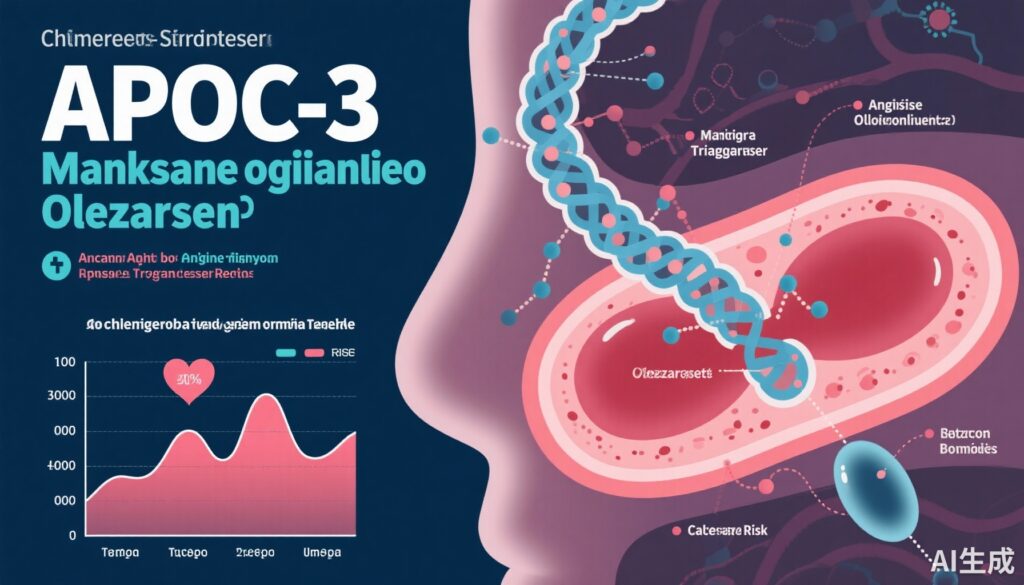Highlights
- Olezarsen, an N-acetylgalactosamine-conjugated antisense oligonucleotide, reduces APOC3 expression and robustly lowers triglyceride levels by over 58% in moderate hypertriglyceridemia.
- Phase 3 ESSENCE-TIMI 73b trial demonstrates significant triglyceride reduction with both 50 mg and 80 mg monthly subcutaneous dosing versus placebo, with comparable safety profiles.
- Olezarsen effectively lowers apoC-III across multiple lipoprotein fractions, improves lipoprotein particle profiles, and reduces biomarkers of pancreatitis in familial chylomicronemia and hypertriglyceridemia syndromes.
- Emerging antisense and RNA interference therapies targeting APOC3, such as plozasiran and volanesorsen, show promising lipid profile modulation supporting cardiovascular risk reduction strategies.
Background
Elevated triglyceride levels contribute to residual cardiovascular risk despite optimal LDL cholesterol management. Moderate hypertriglyceridemia (150–499 mg/dL) is prevalent and associates with accelerated atherogenesis and pancreatitis risk. Historically, effective triglyceride-lowering therapies have been limited, with statins mainly targeting LDL, and fibrates and omega-3 fatty acids showing variable efficacy and safety concerns. Apolipoprotein C-III (apoC-III) is a key regulator that inhibits lipoprotein lipase (LPL)-mediated clearance of triglyceride-rich lipoproteins (TRL). Inhibition of APOC3 mRNA reduces apoC-III production, enhancing triglyceride clearance.
Olezarsen is a GalNAc (N-acetylgalactosamine) conjugated antisense oligonucleotide designed for hepatocyte-specific APOC3 mRNA degradation, leading to decreased apoC-III protein levels and triglyceride reduction. This technology aims to offer potent and targeted triglyceride lowering with a favorable dosing regimen and safety profile.
Key Content
Phase 3 Clinical Evidence: ESSENCE-TIMI 73b Trial
The pivotal trial by Bergmark et al. (N Engl J Med 2025) enrolled 1,349 patients with moderate hypertriglyceridemia and elevated cardiovascular risk or severe hypertriglyceridemia (≥500 mg/dL). Patients were randomized to receive monthly subcutaneous olezarsen at 50 mg or 80 mg or matched placebo, with primary endpoint being placebo-adjusted least-squares mean percent change in triglycerides at 6 months.
Results demonstrated substantial triglyceride reductions: 58.4% for 50 mg and 60.6% for 80 mg olezarsen groups versus placebo (P<0.001 for both). The median baseline triglycerides were ~238 mg/dL. Safety was comparable across groups with no significant increase in serious adverse events. This trial underscores olezarsen’s robust triglyceride-lowering efficacy in a large, well-characterized population.
Mechanistic Insights and Lipoprotein Effects
Supplemental studies in familial chylomicronemia syndrome (FCS) and mixed hyperlipidemia elucidate olezarsen’s effects on apoC-III and lipoprotein subclasses. Bergmark et al. (Atherosclerosis, 2025) reported olezarsen induced reductions in apoC-III across multiple lipoprotein pools, notably total apoB-containing lipoproteins and apoA-I (HDL), confirming broad apoC-III suppression.
Moreover, olezarsen favorably modulated plasma lipase levels, potentially reflecting reduced subclinical pancreatic injury in FCS patients (J Clin Lipidol 2025), with parallel lowering of apoC-III and triglycerides. These studies provide translational links between apoC-III inhibition, improved lipoprotein metabolism, and clinical outcomes.
Comparative and Complementary Approaches
Other apoC-III-targeting agents such as plozasiran (siRNA platform) similarly demonstrate triglyceride reductions and favorable shifts in lipoprotein particle size and quality (J Am Coll Cardiol 2025). The emerging class of APOC3 inhibitors may offer synergistic or alternative approaches depending on patient-specific profiles.
Additional treatments targeting other modulators of triglyceride metabolism, including ANGPTL3 inhibitors (e.g., SHR-1918), have shown LDL and triglyceride reductions but raise concerns about hepatic fat accumulation (J Clin Lipidol 2024). Olezarsen’s hepatocyte-targeted mechanism appears effective without significant off-target effects.
Cardiovascular Outcomes and Broader Implications
Triglyceride lowering is associated with reductions in cardiovascular events and mortality, especially in diabetic populations (Atherosclerosis 2024 meta-analysis). Although direct outcome trials of olezarsen are forthcoming, lipid and biomarker improvements suggest potential for cardiovascular risk mitigation.
Comparisons with other lipid-lowering agents such as PCSK9 inhibitors and high versus moderate intensity statin therapy underline the importance of multi-targeted lipid management, particularly for remnant lipoproteins and triglyceride-rich particles, where apoC-III plays a pivotal role.
Expert Commentary
Olezarsen represents a significant advance in targeting triglyceride metabolism through selective APOC3 silencing. The magnitude and consistency of triglyceride reduction in ESSENCE-TIMI 73b, alongside favorable safety, position olezarsen as a promising therapy for moderate to severe hypertriglyceridemia.
Mechanistically, suppression of apoC-III on various lipoprotein subclasses reduces TRL particles and improves clearance, offering a pathophysiologic rationale for cardiovascular benefit. The translational data in familial chylomicronemia syndromes also support its use in rare dyslipidemias with high pancreatitis risk.
However, long-term cardiovascular outcomes and real-world effectiveness remain to be fully established. Issues such as durability of response, integration with existing lipid-lowering regimens, cost-effectiveness, and patient selection will be critical for clinical uptake.
Challenges include monitoring and managing rare adverse events like platelet reductions noted with earlier apoC-III inhibitors. The GalNAc conjugation permits less frequent dosing and improved hepatic targeting, potentially mitigating systemic side effects.
Given recent neutral results with other triglyceride-lowering agents (e.g., pemafibrate), the comprehensive lipid and apoC-III lowering of olezarsen, along with pancreatic enzyme improvements, may translate into net clinical benefits warranting confirmatory trials.
Conclusion
The clinical development of olezarsen affirms antisense oligonucleotide technology as a potent and selective approach for reducing apoC-III and triglycerides. Phase 3 evidence robustly supports its efficacy and safety in moderate hypertriglyceridemia with cardiovascular risk, bridging a significant therapeutic gap.
Ongoing studies will elucidate its impact on cardiovascular outcomes and pancreatitis prevention. Future research should explore long-term safety, optimal combination therapies, and personalized medicine approaches leveraging apoC-III modulation.
Targeting APOC3 with olezarsen emerges as a promising strategy to mitigate residual cardiovascular risk attributable to elevated triglycerides and to improve metabolic health in patients with hypertriglyceridemia and its complications.
References
- Bergmark BA, et al. Targeting APOC3 with Olezarsen in Moderate Hypertriglyceridemia. N Engl J Med. 2025;393(13):1279-1291. doi:10.1056/NEJMoa2507227. PMID: 40888739.
- Bergmark BA, et al. Effect of olezarsen on lipoprotein-associated ApoC-III levels in patients with familial chylomicronemia syndrome. Atherosclerosis. 2025;408:120462. doi:10.1016/j.atherosclerosis.2025.120462. PMID: 40706406.
- Goodrich EL, et al. Effect of olezarsen on routinely measured lipase and amylase levels in familial chylomicronemia syndrome. J Clin Lipidol. 2025;19(4):1109-1118. doi:10.1016/j.jacl.2025.05.007. PMID: 40640035.
- Dewey FE, et al. Effect of Targeting ApoC-III With Plozasiran on Lipoprotein Particle Size and Number in Hypertriglyceridemia. J Am Coll Cardiol. 2025;85(19):1839-1854. doi:10.1016/j.jacc.2025.03.496. PMID: 40099777.
- Xu Y, et al. Angiopoietin-Like 3 Antibody Therapy in Patients With Suboptimally Controlled Hyperlipidemia: A Phase 2 Study. J Am Coll Cardiol. 2025;85(19):1821-1835. doi:10.1016/j.jacc.2025.03.008. PMID: 40167414.
- Boekholdt SM, et al. Triglyceride-lowering therapy for the prevention of cardiovascular events, stroke, and mortality in patients with diabetes: A meta-analysis of randomized controlled trials. Atherosclerosis. 2024;394:117187. doi:10.1016/j.atherosclerosis.2023.117187. PMID: 37527961.


